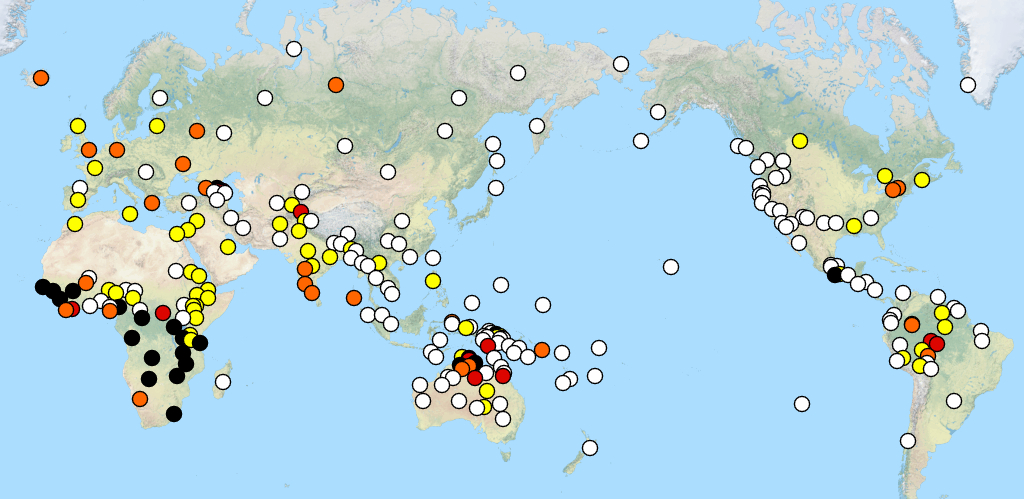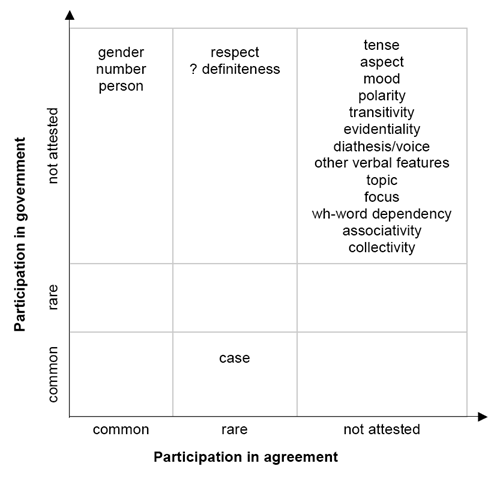Grammatical Features Inventory
Overview

Figure 1. Number of genders (Corbett 2013). In some languages gender is evident in almost every phrase, while in other languages it is absent. This map from the World Atlas of Language Structures Online shows the distribution of gender as a grammatical feature in 256 languages: white = none; yellow = two; orange = three; red = four; black = five or more.
An introduction to grammatical features
In attempting to understand language, many researchers use features, the elements into which linguistic units, such as words, can be broken down. Examples of features are NUMBER (singular, plural, dual, ...), PERSON (1st, 2nd, 3rd), and TENSE (present, past, ...). Features have proved invaluable for analysis and description, and have a major role in contemporary linguistics, from the most abstract theorising to the most applied computational applications. Yet little is firmly established about features: we have no inventory of which features are found in the world's languages, no agreed account of how they operate across different components of language, no certainty on how they interact, and thus no general theory of features. They are used, but are little discussed and poorly understood. This is a central gap in the conceptual underpinning of much linguistic investigation.
The Grammatical Features Inventory offered here is an attempt to put the notion of linguistic 'feature' on a sounder empirical and conceptual base. It aims to provide evidence for the diverse content of features in the world's languages, as well as discuss some of their formal properties, particularly in morphology (word structure) and syntax (sentence structure).
Organisation of the feature inventory
The aim of the project 'Grammatical features: A key to understanding language' was to identify morphosyntactic features, and we investigated a variety of features which could be thought to have this status. This class includes features for which we have found evidence of their relevance to morphosyntax. The remaining features, which we investigated but which do not fall into the morphosyntactic category, have been classified as morphosemantic (but not relevant to syntax) or morphological (but not relevant to syntax).
|
Morphosyntactic features |
Morphosemantic features |
Morphological features |
|
Typically morphosyntactic: Rarely morphosyntactic:
|
Mood Polarity Diathesis & Voice Evidentiality Question Word Dependency |
The definitions given in the sections above correspond to canonical morphosyntactic, morphosemantic, and morphological features. No feature in any language has values which are consistently realised in the permitted ways across all relevant elements. However, in a given language, we recognise the feature as morphosyntactic if its values are involved in either government or agreement for any set of elements. In turn, a morphosemantic feature in a given language is a feature which is inherent only; that is, there are no elements (word classes or lexemes) for which it is contextual.
Principles of feature classification
In our search for possible morphosyntactic features, we have found at least one language (for each feature) in which the following features can be morphosyntactic:
| participates in agreement | participates in government | |
|---|---|---|
| gender | √ | |
| number | √ | |
| person | √ | |
| case | √ | √ |
| definiteness | √? | |
| respect | √ |
However, while some of these are typical features of agreement or government and occur very commonly, others only rarely play a role in syntax. The following map shows how they share out the load of work in syntax between them. The categories which we have not found to participate in either agreement or government are often morphosemantic features:

The structure of the entries reflects our approach to each candidate feature. We began our investigation of each feature by looking for its morphological exponent. Ideally, for each feature and value one should be able to identify a phonological segment that realises it. ("[T]o demonstrate the existence of a category, evidence of distinctions in form is necessary" Corbett 1991:147). However, it turns out that not just values, but even features themselves can be non-autonomous. An example of this can be found in the "Person" entry, where in the "Problem cases" section we discuss the non-autonomous person feature in Archi which does not have unique phonological realisation, but where the particular choice of gender and number markers is used to distinguish persons 1 and 2 from person 3.
Each feature entry is structured as follows:
- §1 discusses the cognitive foundations of the feature and, where relevant, the type of the inherent realisation of the feature (e.g. what has been referred to as the 'assignment system' of a feature);
- §2 discusses the expressions of the feature, particularly morphological and syntactic ones;
- §3 analyses the status of the feature and looks for justification of treating it as morphosyntactic, bearing in mind that the feature in question may have different status in different languages;
- §4 offers some discussion of the values of the feature, listing possible values, citing the largest and smallest systems that have been encountered, and the structuring within values, if there is any;
- §5 collects short descriptions of oddly behaving markers of the feature under investigation, especially the unexpected effects of one feature on another;
- §6 outlines problem cases and questions that have been posed in relation to the discussed feature in particular languages, highlights common pitfalls or analyses that may still be in circulation but have been disproven;
- §7 lists key literature and all references, providing links to electronically available publications and resources where available.
References
- Anderson, Stephen R. 1982. Where's morphology? Linguistic Inquiry 13:571-612.
- Booij, Geert. 1994. Against split morphology. In: Booij, Geert & Jaap van Marle (eds) Yearbook of Morphology 1993. Dordrecht: Kluwer. 27-49.
- Booij, Geert. 1996. Inherent versus contextual inflection and the split morphology hypothesis. In: Booij, Geert & Jaap van Marle (eds) Yearbook of Morphology 1995. Dordrecht: Kluwer. 1-15.
- Bybee, Joan L. 1985. Morphology: A Study of the Relation between Meaning and Form. Amsterdam: Benjamins.
- Castairs-McCarthy, Andrew. 1999. Category and feature. In: Booij, Geert, Christian Lehmann, Joachim Mugdan & Stavros Skopeteas (eds) Morphology. An International Handbook on Inflection and Word-formation. Berlin: Walter de Gruyter. 264-272.
- Chomsky, Noam. 1965. Aspects of the Theory of Syntax. Cambridge, MA: MIT Press.
- Chumakina, Marina, Anna Kibort & Greville G. Corbett. 2007. Determining a language's feature inventory: person in Archi. In: Austin, Peter K. & Andrew Simpson (eds) Endangered Languages. [Linguistische Berichte, Sonderheft 14]. Hamburg: Helmut Buske. 143-172.
- Comrie, Bernard. 1986. On delimiting cases. In: Richard D. Brecht & James S. Levine (eds) Case in Slavic. Columbus, OH: Slavica. 86-106.
- Corbett, Greville G. 1991. Gender. Cambridge: CUP.
- Corbett, Greville G. 2000. Number. Cambridge: CUP.
- Corbett, Greville G. 2006. Agreement. Cambridge: CUP.
- Corbett, Greville G. & Matthew Baerman. 2006. Prolegomena to a typology of morphological features. Morphology 16.231-246. Draft available at: http://epubs.surrey.ac.uk/cgi/viewcontent.cgi?article=1000&context=smgjournal
- Evans, Nicholas. 1995. A Grammar of Kayardild, with Historical-Comparative Notes on Tangic. Berlin: Mouton de Gruyter.
- Evans, Nicholas. 2003. Typologies of agreement: some problems from Kayardild. In: Brown, Dunstan, Greville G. Corbett & Carole Tiberius (eds) Agreement: A Typological Perspective [Special issue of the Transactions of the Philological Society 101(2)]. Oxford: Blackwell. 203-234.
- Gazdar, Gerald, Ewan Klein, Geoffrey K. Pullum & Ivan A. Sag. 1985. Generalized Phrase Structure Grammar. Blackwell: Oxford.
- Givón, Talmy. 2001. Syntax. An Introduction. Volume I. Amsterdam: John Benjamins.
- Kibort, Anna. 2010. Towards a typology of grammatical features. In: Kibort, Anna & Greville G. Corbett (eds) Features: Perspectives on a Key Notion in Linguistics. Oxford: Oxford University Press. 64-106.
- Matthews, P.H. 1972. Inflectional Morphology. Cambridge: CUP.
- Matthews, P.H. 1991. Morphology. Second Edition. Cambridge: CUP.
- Mel'čuk, Igor A. 1993. Cours de morphologie générale. Vol. I: Introduction et première partie: Le mot. Montréal: Les Presses de l'Université de Montréal; Paris: CNRS Éditions.
- Schenker, Alexander M. 1955. Gender categories in Polish. Language 31(3):402-408.
- Stump, Gregory T. 2001. Inflectional Morphology: A Theory of Paradigm Structure. Cambridge: CUP.
- Stump, Gregory T. 2005. Word-formation and inflectional morphology. In: Štekauer, Pavol & Rochelle Lieber (eds) Handbook of Word-Formation. Dordrecht: Springer. 49-71.
- Svenonius, Peter. 2007. Interpreting uninterpretable features. Linguistic Analysis 33:375-413.
- Wurzel, Wolfgang Ullrich. 1984. Flexionsmorphologie und Natürlichkeit. (Studia grammatica 21). Berlin: Akademie-Verlag. [English translation 1989: Inflectional Morphology and Naturalness. Dordrecht: Kluwer].
- Zaliznjak, A.A. 1964. K voprosu o grammatičeskix kategorijax roda i oduševlennosti v sovremennon russkom jazyke. Voprosy jazykoznanija 4:25-40.
- Zaliznjak, A.A. 1973. O ponimanii termina 'padež' v lingvističeskix opisanijax. In: A.A. Zaliznjak (ed.) Problemy grammatičeskogo modelirovanija. Moscow: Nauka. 53-87.
- Zwicky, Arnold M. 1985. How to describe inflection. Berkeley Linguistic Society 11:372-386.
- Zwicky, Arnold M. 1986. Imposed versus inherent feature specifications, and other multiple feature markings. Indiana University Linguistics Club Twentieth Anniversary Volume. 85-106.

